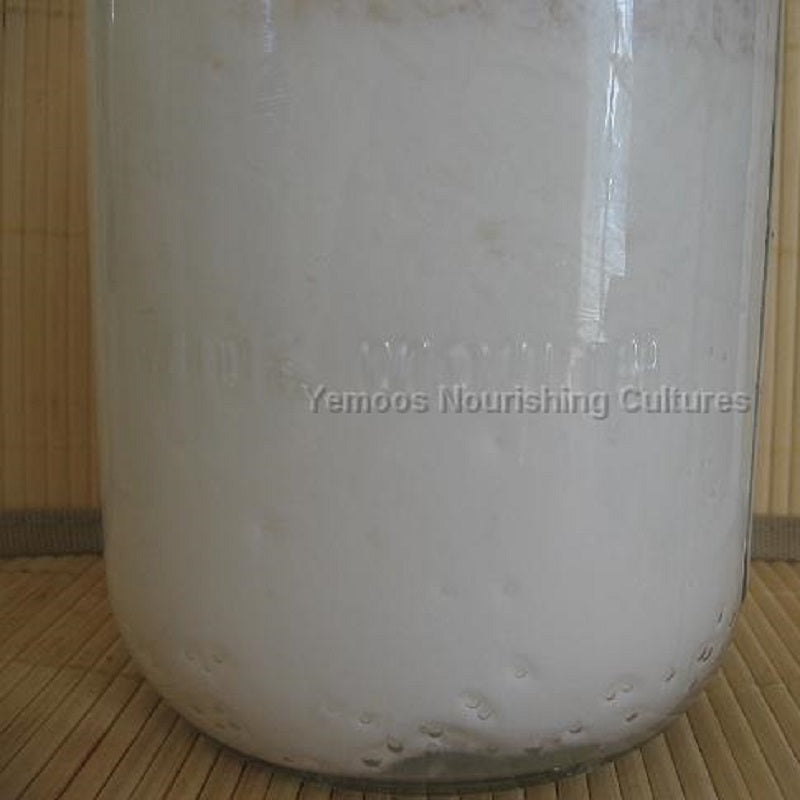
Generally most people desire to keep their milk kefir bacteria rich instead of yeasty. The yeast is responsible for the effervescent and multi-dimensional qualities, so its definitely important, but too much and its becomes less appealing.
Yeasty kefir will ferment fast, fizzy and thin.

Milk kefir has a tendency to slowly shift towards the yeast if its not under ideal conditions. But there are ways to help shift the balance in favor of the bacteria.
1. Use Raw Milk
Raw milk is filled with good bacteria (and enzymes) and that means its very hard for the yeast to take over no matter what you do. I've never seen raw milk kefir go the yeasty route. It's the most fool proof way to keep it bacteria rich, slow and usually thick. Granted that in many states and countries, it is very different to locate a good quality raw milk. Raw milk kefir is best, but pasteurized milk kefir is still a very healthy alternative. So if you go the pasteurized route there are still ways to keep it as bacteria rich as possible by following the rest of the list.
2. Ferment Colder
Try consistently fermenting the kefir at 65-70 degrees. The slightly cooler temperatures favor a slower more bacteria rich ferment.
Avoid temperatures below 65 if possible as it can sometimes cause an improper ferment.
Also avoid temperature fluctuations. Fluctuations stress out the kefir and when the grains get stressed, the yeast tends to take over as the yeast is faster and more opportunistic than the bacteria.
3. Use more milk
Over-fermentation can stress out the grains and any stress can lead to yeasty grains. Using more milk will help naturally balance the grains. The yeast tends to be faster and more opportunistic, so if there's not enough milk, it can steal the needed nutrients and sugars and not leave much for the bacteria to thrive on. With plenty of milk, there should be enough for both the bacteria and yeast.
4. Ferment longer than 24 hours
Grains can adapt to longer schedules and this will ultimately help the bacteria. If you do consistent 48-72 hour batches, It will adapt to this new schedule and will ferment slower, more bacteria rich and many times thicker. Longer ferments naturally help the bacteria as it tends to be slower than the yeast and it takes time for the bacteria to catch up to the yeast. If you are continually doing short ferments, the yeast can sometimes continually have the upper hand.
5. Bury the grains in yogurt technique

Simply bury the grains in a jar of plain yogurt for a few days in the fridge. The idea behind this technique is that yogurt is rich in bacteria with little to no yeast and that environment will help shift the balance from yeasty to bacteria rich. I've heard mixed results from this technique. Sometimes it works great, but may not be aggressive enough if the grains are really yeasty.
6. Occasional long ferment technique
This technique tends to help to some degree and can be done multiple times for better results. Basically the idea is to do the occasional 2-3 day ferment and it will naturally over-ferment, but in that environment the bacteria has a chance to catch up to the yeast and the yeast tends to calm down a bit. When you go back to the regular 24 hour schedule, it tends to be slower and more bacteria rich. I've seen grains that refused to grow because of the yeasty environment, start growing again after doing this technique. You can do this technique a couple times, but its best not to continually over-ferment them as that will stress them out.
7. Fridge Ferment
Ferment exclusively in your fridge to help calm the yeast and keep it bacteria rich. It takes about a week but can vary with different fridge temperatures. Most people notice that its gets thicker too. Sometimes if the grains are really yeasty, it can stay that way even in the fridge. One aggressive trick is to give the grains a really good rinse and then ferment in the fridge.
8. Aggressive rinsing and resting
This technique should only be done as a last resort. The aggressive rinsing and resting will rinse away beneficial surface bacteria and yeast that the grains will have to rebuild which can take several batches. Basically you simply rinse the grains really well in unchlorinated water and leave them in in fresh unchlorinated water for 2-3 days. A less aggressive form on this technique is to let them rest in milk for 2-3 days.



Comments
Beverly Anthony
I let my milk kefir sit for 48 hours and it separated looking like spoiled milk. Is this the yeasty appearance everyone was talking about? It looked like oil at the bottom and thick spoiled milk at the top
October 09, 2017
Alex Parker
If grains are growing well, they are usually not yeasty (as strong bacteria is responsible for good growth). Sometimes at the initial stages of excess yeast, everything grows well and then suddenly slows down. But if they have been growing well for awhile, its likely not overly yeasty. Some other ways to tell its yeasty is a strong bread or alcohol type smell. If its minor its normal though. If the kefir is fermenting really fast, really fizzy and really thin then that is your best indication that there is too much yeast.
August 17, 2017
Manuel manti
Hello. How can I identify yeasty kefir?
My kefir smell strange, a bit different than when they send it to me. I think that it is a yeasty smell but I can’t compare with anything so I don’t know.
Also I think that my stomach is not receiving much improvement.
However my kefir grains grow very fast. Not sure if it is the yeast growing or that maybe they are not yeasty.
August 12, 2017
Teresa
This article was very informative but I’m at a loss as to how you know which is yeasty and which is bacteria kefir. Would you please explain the difference
August 04, 2017
Barbara Greenwood
With the yogurt technique, do you need to rinse the yogurt off before using the grains again?
July 18, 2017
Lisa
“Yeasty kefir will ferment fast, fizzy and thin.” This is EXACTLY my problem with grains I bought dried from another place, while the fresh grains I received from you ferment beautifully under the exact same conditions. Thank you for solving the mystery!! I am going to try fermenting the yeasty grains in raw milk—and I know what to do if the problem develops in my new grains!
April 25, 2017
Justin B
Keeping it cooler worked for us. Now getting a more even kefir, which appears to be thicker and more satisfying. Very nice when chilled after straining!
March 27, 2017
Leave a comment